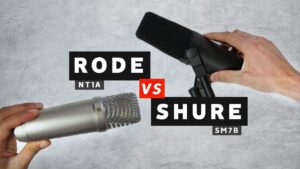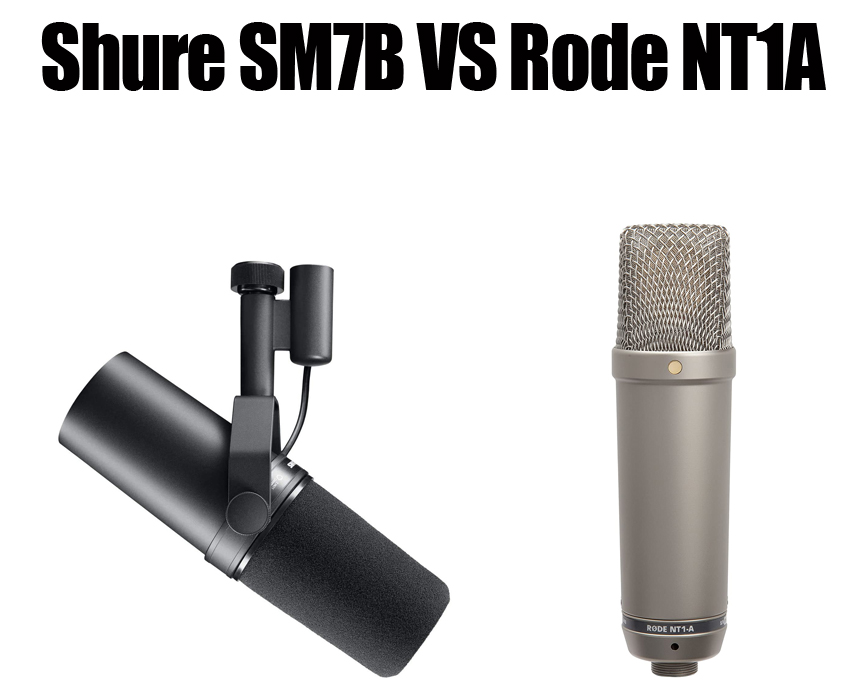Shure 7B Vs Rode NT1 Review – Best Of Both Worlds
Content Navigation
Shure 7B Dynamic Microphone
The Shure 7B microphone isn’t the type of microphone you will find in the non-expensive category. The Shure 7B microphone is one that has a high price tag attached to it because you are not just paying for any microphone, but you are paying for its premium construction and the level of performance it offers.
This is a studio staple microphone that every sound engineer, vocalist, and audio enthusiast will like to work with, and we want to break down the types of people that should not miss out on working with the Shure 7B microphone. These people are the professional audio mixers, vocalists, and podcasters.
Podcasters
Every podcaster out there should not miss out on using this dynamic microphone when recording a podcast, and this is based on the fact that this microphone produces an outstanding vocal reproduction, while its off-axis rejection is topnotch.
All of these are possible because of its cardioid polar pattern, and the off-axis makes it possible for you eliminate unwanted noise in the background if you cannot afford working or recording in a professional room. Podcasters can count on this microphone to deliver crystal clear and crisp sound production.
Professional Audio Mixers
The professional audio mixers will love working with this microphone as it offers a high pass frequency response, cutting down on low frequency electronic sounds that the instrument you’re working with produces. This guarantees obtaining an excellent post production result, making it easy and convenient for you to make edits when necessary.
Vocalists
Vocal singers will love working with the Shure 7B microphone as it has proved to be the ideal companion when it comes to recording vocals in a controlled environment. Depending on the type of effect a vocalist wants to obtain, you can consider working with any of its three frequency responses like bass roll-off, flat, and frequency boost responses.
Checking out the build of the Shure 7B microphone, the integrity and consistency the Shure brand has always maintained while designing all of its microphone reflects in this solidly built microphone. It oozes of premium construction which contributes to why this microphone has an expensive price tag slammed on it.
It comes with a yoke mounting mechanism that makes attaching and detaching this microphone very brilliant and easy, and users can count on its smooth yoke adjustment to provide the desired amount of resistance to keep this microphone in one place and prevent it from falling, despite it being subjected to heavy vibration when used in a live application.
Eliminating fricatives and plosives are functions of the pop filter the Shure 7B microphone comes with, and this means users can speak freely while using this microphone without having to worry about going too close to the recording capsule or not.
Using an external pop filter when testing this microphone is redundant, and the fact that this microphone comes with an additional detachable windscreen ensures bass tones are produced and plosives are eliminated.
In addition, it comes with a user guide that makes installing its windscreen and attaching the microphone quite easy.
Shure 7B Vs Rode NT1 Review

What interests users and sound engineers the most about this microphone is the fact that Shure made use of advanced internal hardware in protecting the cartridge and other components of this microphone, and it also comes with an air suspension shock design that cuts down on mechanical noise so they won’t find their way to your recording. This is another reason why this microphone is perfect for podcasting.
Surprisingly, the Shure 7B microphone offers users total control of whatever they are working on before they start recording. Let us explain more about the frequencies of the Shure 7B microphone.
Bass Roll-Off
The bass roll-off functions just like when you make use of a high-pass filter on a digital audio interface, causing low frequencies to get attenuated. This therefore leads to shutting down of potential distortion and electrical hums which could be caused by proximity effect.
Flat
If you are a user seeking for natural audio reproduction, the flat frequency response is the best for you to make use of. Its versatility is what makes it a good choice for music and speech, but it has its downsides. When using the flat frequency response, proximity effect can affect the audio quality of your recording, especially if you are a vocalist with a low voice, or if you are recording a heavy duty instrument.
Presence Boost
Also called the mid-range emphasis, this frequency response functions like the bass roll-off frequency response. The only difference is the presence boost adds more amplification to its treble and mids. This frequency response is preferred if you are working with high pitched instrument like the guitar or violin.
The Shure 7B microphone is a dynamic microphone that makes use of the cardioid polar pattern, and what this means is this microphone is less sensitive to loud noise and it is completely sturdy. To simplify the last statement, the Shure 7B microphone is designed to prevent signal distortion and audio clipping when working with loud outputs. Since this is a one pickup pattern microphone, it is suited for generalists.
It is best used by singers, announcers, podcasters, and professional audio mixers who speak directly in front of a microphone. The forgiving nature of this microphone is one of its feature that doesn’t get talked about enough, and working with this microphone means you have to be precise about how and where you place it. Placing this microphone is very vital, because you need to focus it more on user’s performance than logistics.
Below are some key notes you should be aware of before working with the Shure 7B microphone;
- It doesn’t matter whether you are working in a professional studio or blanket port, you need to make use of a mic stand. You can consider using a mounted boom arm if you are a podcaster working from a desktop.
- XLR cables are needed in connecting the Shure 7B microphone to a mixer or audio interface
- Surprisingly, the Shure 7B microphone doesn’t require phantom power to function. When used with a CL-1 cloudlifter, the microphone isn’t exposed to damage.
Rode NT1 Condenser Microphone
The Rode NT1-A microphone on the other hand is another microphone designed to have so many interesting features, leaving it with the ability to deliver amazing audio sound reproduction. If you are famous with YouTubers, you must have noticed one of them making use of the Rode NT1-A microphone.
This microphone is more than just being used for video blogging purposes, as it can be used in a professional or home studio setup.
This is an affordable condenser microphone that has been going strong since it first got released in 2003, but there are so many features people find appealing about this microphone. This might not be a very cheap microphone, but it is also not expensive at the same time.
It is best suited for anyone that wants to move away from using USB microphone, and it is a good microphone choice for anyone looking for a microphone to invest in.
This microphone will get the job done whether you want to sing with it or use it for podcast. You will have no problem using this microphone if you make use of an audio interface or voice recorder that will provide phantom power.
You will not find this microphone in the hands of local newscasters, and it is the kind of microphone you can move around with much. It is perfect for a studio setting.
If you have the right equipment, you will not find it difficult to setup the Rode NT1-A microphone. Because it isn’t a USB microphone means you can just take it out of the box, plug it into a USB slot and start making use of it. It requires you to make use of an XLR cable in connecting it to a voice recorder or audio interface. Fortunately for everyone, this microphone comes with a carrying case, shock mount, and 6m long cable.
After mounting on connecting the XLR cable to your preferred interface, the only thing you will know how to do next is learning how to power and position this microphone. Just like most condenser microphone, the Rode NT1-A microphone might requires additional amount of power to start it up.
This is where needing a phantom power comes into play, and users need to be aware of the fact that the Rode NT1-A microphone has high sensitivity.
This means this microphone will pick up low noises easily, and it will have a very good range if it is combined with a maximum sound pressure level. This makes this microphone the best in recording vocals, ensuring that it picks up whispers and full blown sounds.
In terms of build and design, this microphone is solidly built, combined with a sleek appearance. Nevertheless, you should be careful about dropping this microphone accidentally, and it isn’t a portable microphone.

